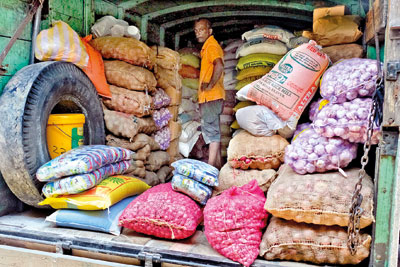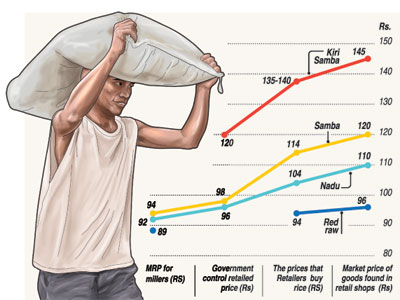News
Bumper harvest falls victim to cooked-up rice prices
Despite a bumper harvest of paddy and the Government insisting there were plentiful stocks, rice shortages continued to be reported from the markets.
The head of the Agriculture Department, Dr. W.N.W. Weerakoon, was blunt: there is enough rice to feed the nation until next February he said, with 1.1 million tons of rice taken from the 1.8 million-ton Yala paddy harvest.
“The shortage of rice only exists in the market. The millers and the merchants are responsible for it,” he charged.

Pettah wholesale market: A few bags of rice amidst potatoes, onions aplenty. Pic by Amila Gamage
He said if the government maintained buffer stocks millers would be prevented from hiking up prices by creating false shortages.
The Paddy Marketing Board (PMB) said it had insufficient stocks to regulate prices.
In answer to complaints by merchants that the PMB was holding back rice stocks and thus allowing millers to hike up prices, board Chairman Jataal Mannapperuma said the PMB only had 30,000 tons of paddy in store.
This was insufficient to control market prices, he said, adding that another 30,000 tons were with district secretariats.
Mr. Mannaperuma said the PMB would next week be releasing rice to Lanka Sathosa outlets and other outlets that maintain government controlled-prices.
“We cannot just send our stock to the market. The Cabinet has to instruct us to release our stock. We only received the order to release our rice a few days back,” he said.
He expected those stocks to last six weeks and said the PMB would increase its purchase to 300,000 metric tonnes at the next harvest.
Both wholesale and retail shop owners claim big millers are controlling the price of rice by taking the larger portion of the paddy harvest. They said that because they are forced to buy at high prices from the big millers they cannot sell at the lower prices mandated by the government.
The large mills sold rice with conditions attached, and while they claimed to be selling some varieties at government prices they charged separately for transport, thus making up their desired price, merchants said.
Wholesale shop owner Chandana Amaratunga said nadu and samba rice were unobtainable at government prices.
When he contacted large-scale millers to buy nadu rice at government prices, they had offered to sell only on condition he also bought kiri samba – as much as two-thirds more than the volume of nadu he sought.
Kiri samba, Mr. Amaratunga pointed out, had controlled price, and so millers were charging a high price of Rs. 135 a kilo for that rice.
He also said that one of the millers recently delivered rice at government-controlled prices but added extra charges to the bill.

“How can I sell a kilo of samba rice for Rs. 96 if I have spent over Rs. 100 to buy it?” he demanded. “How can earn a profit when the wholesale rice prices have exceeded the government-controlled maximum retail price?”
Retailers expressed anger that the price control system and the Consumer Affairs Authority’s (CAA) inability to stop millers from over-charging.
Maheshika Senaratne, a retail shopkeeper in Piliyandala, complained that the CAA only fined retailers for selling nadu and samba at prices above the controlled level.
“The officials don’t investigate and find out the millers’ prices and the stipulations imposed on us when we place orders,” she said.
“Last week, the millers sold us nadu for Rs. 104 a kilo and samba for Rs. 114 when the government wanted them to sell nadu for Rs. 92 and samba for Rs. 94. There is no-one taking action over that,” she said. She added that when she placed an order this week that she was told that she had to purchase 200 five-kilo bags of kiri samba in order to buy 100 five-kilo bags of nadu.
Rebutting charges of inaction, a senior CAA official said his officers were conducting 2,000 raids a month. “The merchants have to stop buying rice at conditional prices from millers,” he said. “They can then complain to us. Then we take action.”
He said the CAA had recently issued stern warnings to mill owners about jacking up prices but that effort had been in vain because the next day a gazette had been issued, revising prices in the millers’ favour.
The Chairman of the United Rice Producers Association, Mudith Perera, pointed out that the government should take transport and other expenses and interest rates into consideration when imposing price controls. Small-scale millers were unable to cover such expenses and still sell at controlled prices, he said.
He said prices paid by the Paddy Marketing Board and district secretaries varied by Rs. 44-50 a kilo.
This happened because district secretaries had been asked to buy wet paddy for Rs. 44 a kilo, which made millers make that sum their general buying prices for paddy although the price of dried paddy was Rs. 53.
The Chairman of the Small and Medium-Scale Millers Association, B.K. Ranjith, said that around 1,000 of his members had stopped milling paddy for two weeks but would resume operations. He predicted prices would exceed Rs. 120 a kilo as millers could not buy paddy at prices below government klevels.
Additional reporting by Hiran Priyankara

